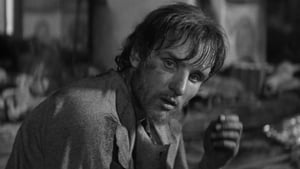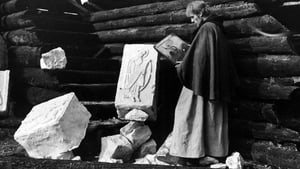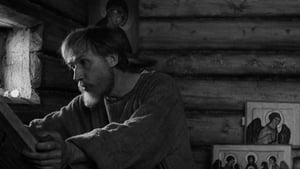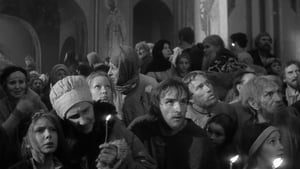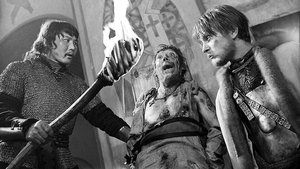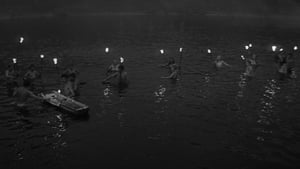Contact: info@alwanfilm.com
Video Sources 0 Views
- Watch trailer
- Andrei Rublev

Synopsis
Table of Contents
ToggleReview: Andrei Rublev 1966 Colorized – Exploring the Impact of Early Colorization

Introduction
In the vast tapestry of cinematic history, few films stand as tall and enigmatic as Andrei Rublev 1966. Directed by the visionary filmmaker Andrei Tarkovsky, this epic masterpiece delves into the life and times of the famed Russian iconographer Andrei Rublev. However, what sets this exploration apart is its recent re-release in an early colored version, igniting debates among cinephiles and scholars alike. In this article, we embark on a journey to unravel the significance of this colored rendition and its impact on the timeless narrative of Andrei Rublev 1966.
Check The Full Colorized Movies List
Check Our Colorized Movies Trailer Channel
Understanding Andrei Rublev 1966 Colorized: Director, Cast, and Genre
Andrei Rublev 1966 emerges from the mind of the esteemed Russian filmmaker Andrei Tarkovsky, renowned for his poetic and introspective style. The film boasts a stellar cast, with Anatoly Solonitsyn delivering a haunting portrayal of the titular character, Andrei Rublev. Set against the backdrop of medieval Russia, Tarkovsky deftly navigates the historical epic genre, infusing it with philosophical depth and visual splendor.
Tarkovsky’s vision for “Andrei Rublev 1966” transcends mere storytelling; it’s a meditation on art, faith, and the human condition. Through Rublev’s journey, Tarkovsky explores themes of creativity, spirituality, and the tumultuous nature of existence. The film’s genre defies easy categorization, blending elements of historical drama, religious allegory, and existential meditation.
Exploring the World of Andrei Rublev 1966 Colorized: Plot and Characters
At its core, Andrei Rublev 1966 chronicles the tumultuous journey of the eponymous iconographer amidst the chaos and upheaval of 15th-century Russia. From his encounters with fellow artists to his struggles with faith and artistic expression, Rublev’s odyssey serves as a microcosm of the human condition, resonating with audiences across generations.
The narrative unfolds in a series of vignettes, each capturing a different facet of Rublev’s life and the world around him. From his encounters with a tormented bell-maker to his harrowing experiences during a Tatar invasion, each episode offers a glimpse into the complexities of medieval Russian society. Through Rublev’s eyes, we witness moments of beauty, brutality, and profound introspection.
The Art of Film Colorization
Film colorization, the process of adding color to black and white footage, has long been a subject of contention within the cinematic community. While proponents argue that it revitalizes classic films for contemporary audiences, detractors raise concerns about its impact on the original artistic vision and historical authenticity.
The art of colorization is a delicate balancing act, requiring careful consideration of tone, texture, and mood. When done well, it can breathe new life into familiar images, enriching the viewing experience for audiences. However, it also runs the risk of altering the filmmaker’s intended aesthetic and diluting the film’s thematic resonance.
Early Colored Films: A Brief History
The emergence of early colored techniques in cinema marked a pivotal moment in the industry’s evolution, paving the way for future innovations in visual storytelling. From hand-painted frames to early experiments with tinting and toning, filmmakers have continuously pushed the boundaries of creativity and technology.
Early colored films offered audiences a glimpse into worlds previously unseen, expanding the possibilities of cinematic expression. From the vibrant hues of silent epics to the lush palettes of early Technicolor musicals, colorization opened up new avenues for storytelling and spectacle. However, it also presented challenges in terms of production costs, technical limitations, and artistic integrity.
Andrei Rublev 1966 and Its Early Colored Version
The decision to release “Andrei Rublev 1966” in a colorized format represents a bold artistic choice, inviting viewers to experience Tarkovsky’s magnum opus through a new lens. While purists may lament the alteration of the original black and white aesthetic, others find value in this reinterpretation, highlighting previously unseen details and nuances.
The early colored version of Andrei Rublev 1966 offers a fresh perspective on Tarkovsky’s visual storytelling, enriching the film’s historical tapestry with vibrant hues and atmospheric textures. From the golden glow of candlelit interiors to the verdant landscapes of medieval Russia, colorization adds another layer of depth to the film’s narrative canvas.
The Debate Over Film Colorization
As with any controversial artistic endeavor, the colorization of classic films sparks heated debates within the film community. While some argue for preservation and fidelity to the director’s intent, others advocate for creative experimentation and accessibility to modern audiences. Ultimately, the debate underscores the complex interplay between tradition and innovation in cinema.
The controversy surrounding film colorization reflects broader tensions within the industry between preservation and progress. While purists may decry any deviation from the original black and white aesthetic, others see colorization as a means of breathing new life into classic films for contemporary viewers. As technology continues to advance, the boundaries between art and commerce become increasingly blurred, raising questions about the future of cinematic preservation and interpretation.
Examining Andrei Rublev 1966 as an Early Colored Film
Viewing Andrei Rublev 1966 in its early colored incarnation offers a unique perspective on Tarkovsky’s visual storytelling prowess. From the vibrant hues of medieval landscapes to the subtle nuances of character expression, colorization adds another layer of depth to the film’s narrative tapestry. However, it also raises questions about the balance between artistic reinterpretation and historical authenticity.
For some viewers, the early colored version of Andrei Rublev 1966 may enhance their appreciation of Tarkovsky’s masterwork, providing a fresh interpretation of familiar scenes and themes. For others, it may detract from the film’s original aesthetic and emotional impact, obscuring the stark beauty of its black and white imagery. Ultimately, the decision to embrace or reject colorization is a matter of personal preference, reflecting the diverse perspectives within the cinematic community.
Influence and Legacy: Andrei Rublev 1966 Colorized’s Impact on Cinema
Beyond its immediate impact, Andrei Rublev 1966 Colorized has left an indelible mark on the cinematic landscape, inspiring generations of filmmakers and artists. From its influence on Western remakes to its lasting legacy in Russian cinema, Tarkovsky’s masterpiece continues to resonate with audiences worldwide.
Tarkovsky’s bold exploration of art, faith, and humanity in “Andrei Rublev 1966” has reverberated throughout the annals of cinematic history, inspiring countless filmmakers to push the boundaries of storytelling and expression. From Martin Scorsese to Christopher Nolan, Tarkovsky’s influence can be felt in the work of directors across the globe, underscoring the enduring power of his cinematic vision.
Director’s Cinematic Legacy: Beyond Andrei Rublev 1966 Colorized
Tarkovsky’s cinematic legacy extends far beyond “Andrei Rublev 1966,” encompassing a diverse body of work that transcends genre and convention. His profound insights into the human condition, coupled with his mastery of visual storytelling, cement his status as one of cinema’s most revered auteurs.
From the haunting landscapes of “Solaris” to the metaphysical mysteries of “Stalker,” Tarkovsky’s films continue to captivate and confound audiences with their poetic beauty and philosophical depth. His oeuvre reflects a commitment to exploring the deepest recesses of the human soul, grappling with questions of existence, identity, and transcendence.
Tarkovsky’s cinematic style is characterized by long takes, atmospheric imagery, and existential themes, creating an immersive viewing experience that transcends the boundaries of time and space. His films are not mere entertainment but profound meditations on the nature of reality and the search for meaning in an indifferent universe.
Themes Explored in Andrei Rublev 1966 Colorized
At its core, “Andrei Rublev 1966” grapples with themes of darkness, violence, and morality, painting a stark portrait of the human experience. Through Rublev’s journey, Tarkovsky invites viewers to confront the complexities of existence and the eternal struggle for meaning in an indifferent world.
The film’s exploration of faith and creativity resonates with audiences on a visceral level, tapping into universal truths about the human condition. From Rublev’s agonizing moral dilemmas to his unwavering commitment to his art, the film offers a profound meditation on the nature of belief, sacrifice, and redemption.
Reception and Controversy Surrounding Andrei Rublev 1966 Colorized
The release of “Andrei Rublev 1966” in its early colored version has sparked both acclaim and controversy among critics and audiences. While some praise the newfound vibrancy and depth, others lament the departure from the film’s original aesthetic. Nevertheless, the debate underscores the enduring relevance of Tarkovsky’s masterpiece in contemporary discourse.
Critics have praised the film’s visual beauty, thematic richness, and emotional resonance, hailing it as a towering achievement in cinematic art. However, others have raised concerns about the impact of colorization on the film’s integrity, arguing that it detracts from Tarkovsky’s original vision.
Where to Watch Andrei Rublev 1966 Colorized Online
For those eager to experience the timeless brilliance of “Andrei Rublev 1966,” the film is available on various streaming platforms, ensuring accessibility to audiences worldwide. Whether in its original black and white format or the early colored rendition, Tarkovsky’s opus remains essential viewing for cinephiles and newcomers alike.
FAQs About Andrei Rublev 1966 Colorized
Common queries surrounding “Andrei Rublev 1966” range from its historical accuracy to its thematic resonance in modern times. By addressing these frequently asked questions, viewers can gain a deeper understanding of the film’s enduring appeal and cultural significance.
Q: Is Andrei Rublev 1966 historically accurate?
A: While the film is inspired by the life of the Russian iconographer Andrei Rublev, it takes artistic liberties with historical events and characters. Tarkovsky’s primary focus is not on strict historical accuracy but on exploring timeless themes of faith, art, and humanity.
Q: What is the significance of the film’s title?
A: The title “Andrei Rublev 1966” refers to both the protagonist, Andrei Rublev, and the year of the film’s release. It serves as a tribute to the iconic Russian artist and a marker of the film’s place in cinematic history.
Q: What is the symbolism of the film’s imagery?
A: The imagery in “Andrei Rublev 1966” is rich with symbolism, reflecting Tarkovsky’s deep spiritual and philosophical concerns. From the recurring motif of bells to the haunting landscapes of medieval Russia, each image carries multiple layers of meaning, inviting viewers to contemplate the mysteries of existence.
Conclusion
In conclusion, Andrei Rublev 1966 stands as a towering achievement in cinematic history, its legacy enduring through the ages. While the early colored version offers a fresh perspective on Tarkovsky’s masterwork, purists may still prefer the original black and white presentation. Regardless of personal preference, one thing remains clear: the power of “Andrei Rublev 1966” lies not in its color palette, but in its profound exploration of the human spirit and the eternal quest for artistic truth. As we continue to grapple with the ever-evolving landscape of cinema, let us heed the lessons of Tarkovsky’s masterpiece and strive to honor his visionary legacy for generations to come.
